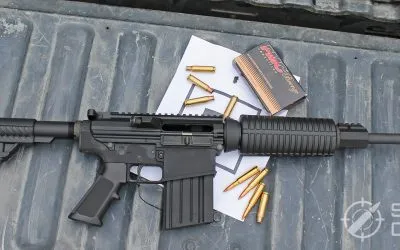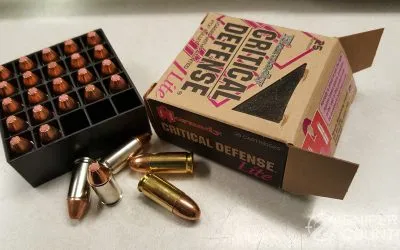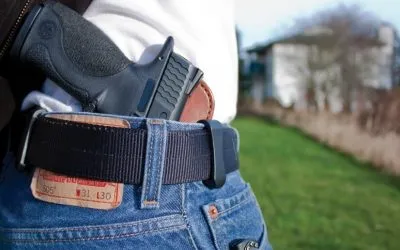Want one of the smallest, pocket-dwelling .380s on the market? Want it to be reliable? How about a laser sight so you don’t have to look through the tiny built-in sights? Want it to be built like a Ruger? Well, here you go… the best of all those worlds, the Ruger LCP. The .380 has turned into the semi-auto version of the .38 Special, what with new ammunition capabilities and advances in technology. I own both, and I carry both — but I don’t feel under-gunned with either. Would I rather have a 9mm or larger caliber? Sure, but let’s not disparage the .380. After all, several European countries used it as a police cartridge for many years and, as mentioned, it fits in a pocket so it’ll go with you most places you go.
The .380 — A Short History
In my review of .380 ammo, I recounted the cartridge’s long and storied history. You can read that here. One of the more interesting aspects of that history was that the .380 was used to perpetrate the heinous act that started WWI. It was the catalyst that plunged first a couple of empires into war with each other and then the domino effect of mutually-supporting treaties brought more and more countries into the growing dispute-that-turned-into-a-war. Eventually, it plunged many of the globe’s countries into a war that lasted just over four years.
The Final Straw
BONUS OFFER: Get your free shooting range targets to print at home!
Get your free targets to print at home!
Anarchist Gavrilo Princip wanted to assassinate Archduke Franz Ferdinand of the Austria-Hungary empire — there are many reasons and actions that led to this desire. Suffice it to say, Princip and his group of Serbian anarchists wanted to end Austria/Hungarian rule of Bosnia and Herzegovina. Events led to the assassination of not only the Archduke, but his wife as well. An FN Model 1910 .380 pistol was the instrument chosen to carry out this task. Why go on about a tragic event that had so many terrible consequences? Simply because of the tool he chose to do the job, a .380 pistol. Since we’re talking about that caliber, the story holds some interest. The .380 did the job, as nefarious as it was.
More Modern Times
Fast-forward to today. The old .380, introduced by Colt in 1908, has slowly grown in popularity (again) over the years. Using the same bullet diameter as the 9mm (.355), the .380’s shorter case means that smaller, lighter bullets must be used. The .380 case is 17mm long, while the 9mm is 2mm longer. These measurements mean that today’s .380 round, in order to be effective, must use new technology in terms of bullets and ballistics since it is not the equal of the 9mm in case/overall length or pressure. Several ammo makers have stepped up to the plate and have designed some really good cartridges for the old caliber.
Here is a diagram from Lucky Gunner.com — a ballistics gel test that shows some pretty impressive penetration from Federal’s Hydra-Shok round. Expansion is not evident here, but with the penetration offered, should not be a huge issue. Remember, this is only one sample test… there are many other brands and types of .380 ammo out there (if you can find any).

Lucky Gunner’s Chris Baker did a really decent article about the .380 — you can read it here.
Anyway, that’s enough about the .380 cartridge — it is a vastly-improved version of its former self. Now, for the gun…
The LCP
What does “LCP” mean? I remember when Ruger’s new Light Compact Pistol first came out. It was introduced at the 2008 SHOT Show. After the gun started shipping, it became a huge hit. Up to that time, there were very few guns that were both pocketable and powerful enough to consider for concealed carry or backup. When the gun came out, I remember how I thought how much like the Kel-Tec P3AT it looked. And, along those lines, I think I remember hearing about some legal doings between Ruger and Kel-Tec, but I couldn’t find anything online about it, so we’ll move on. Having owned the Kel-Tec, I do see similarities but I’m no legal expert — we’ll let it go at that.
It’s important to note that, until the LCP came along, there were darned few pocket guns capable of producing power on a level with the .380. So, when the LCP made its appearance, police personnel and others who had the need (civilian carriers) bought them to put in a pocket holster as back-up or as primary carry. With its included 6-round magazine (plus one in the chamber), you had a couple of rounds more than the typical snubby .38 could give. Add in the optional 7-round mag introduced in 2013 and the scale is tipped even more heavily in favor of the little semi-auto.
The gun earned a bit of notoriety when then-governor of Texas, Rick Perry, used one to dispatch a coyote that was giving his Lab fits. Ruger promptly brought out a version called the “Coyote Special” to commemorate the occasion. The last step in the LCP’s evolution occurred in 2016 when the LCP II was introduced. This was a gun that included a really decent trigger (and trigger safety), better sights, a frame redesign and a slide stop that actually held the slide open after the last round was fired. I’ve handled both of them and the II is a definite improvement — but the original is still being made, and is as popular as ever. After weighing my test gun, I can see at least one reason why – with an empty magazine in place, the gun weighs two more ounces than a half-pound… 10 ounces.
Popular Articles
Before we get much past the weight, let’s look at the gun’s specifications…
| Length: | 5.16" |
| Height: | 3.6" |
| Barrel: | 2.75" |
| Weight (w/empty mag): | 10 oz. (on my digital scale) |
| Capacity: | 6+1 |
| Width: | .82" |
| Trigger pull, measured: | 7 lbs., 6 oz. |
| Grip Frame: | Glass-filled nylon |
| Slide and Barrel Finish: | Black oxide |
| Features: | Viridian red laser, pocket holster, extra mag baseplate |
| MSRP: | $349 |
| "Real-World" price: | ~$275 |
Carrying The Little Guy
Ruger thoughtfully includes a pocket holster with the LCP. This should (hopefully) prevent folks from just sticking the gun in a pocket, loose. The pocket holster will do two things: it will keep the trigger covered and protected, and it will keep the gun oriented correctly in your pocket. So, stick the thing in its holster and take off. That’s about all there is to carrying it. What I didn’t talk about was what comes before you stick the gun in your pocket and walk off – the practice that you’ve done with the gun. Without turning this review into a rant about being qualified to carry a weapon concealed, I’ll suffice it to say that you should take a concealed carry class or two before you venture out armed. If that is out of the question, at least practice shooting the gun regularly. (I know, ammo is hard to find right now but when the supply frees up a bit, practice!). I am not a certified firearms instructor, but you should shoot your gun enough to know a) what type of ammo it functions best with and is accurate with; b) how to draw the gun the same way every time so if you would have to draw it, you don’t have to stop and think about it; and c) be able to hit a definable target at a standard distance. Again, this is not a concealed carry “how-to” — there are plenty of those around — but is simply a plea that you will be trained or get the needed information from an expert before you leave home with the LCP in your pocket or purse.
Why am I making such a big fuss over this? Simple… of the dozens of pistols and revolvers I’ve reviewed over the years, the LCP is one of very few that might actually get stuck in a pocket over other, larger guns and holsters. It’s so “carry-able” that you need to be totally familiar with it, because you will most likely want to carry it. And, let’s face it – small guns are not easy to shoot for many people. As the saying goes, “they ain’t much there to hang onto” with its diminutive, thin grip – two fingers is it (for me at least), with maybe a third on the optional 7-round mag’s extended base with finger extension.
OK, the lecture is over, now you can go get some coffee. Before you go, here are some pics of the gun…

First, here’s the box lid. You know you have something cool when it comes with a warning label on the box!



Frame, left and right.


Why did I include a screwdriver in this photo of the gun field-stripped? Because unless you have Superman’s fingernails, you’ll need something to pop the takedown pin loose.

Check the full-length frame rails. Nice!

Slide engraving. Not too much – I like that.

Nothing here that shouldn’t be. Very clean.

Takedown pin, trigger, mag release and slide stop. The gun does not hold open on the last shot, but you can at least lock the slide back by using the stop. The LCP II fixed this and holds the slide back on the last shot.

Barrel and recoil spring.

Recoil spring(s) and guide rod. The nested springs make it a bit harder to rack the slide, but pay off with lower felt recoil.

No striker here – it uses an old-fashioned hammer. The LCP is a DAO pistol.

Rear sight.

Rear sight, integral with the slide as is the front sight. Here’s a different angle.

Front sight

Magazine with included flat base plate.

Nice pocket holster – included in the box.

Speaking of the box, here’s what’s in it.
Shooting the LCP
We’ve had bad weather hereabouts. I know – most of the country has had bad weather. I really felt sorry for our brothers and sisters in Texas and other areas that were not set up to deal with weather elements like snow, ice, zero-degree readings, etc. as we are where I live. But, 2 degrees is cold wherever you are. Even our chickens turned chicken and wouldn’t come out of the coop. It’s been brutal, but now the snow is melting. I’m ready for the old Disney cartoon portrayal of springtime, with bunnies frolicking on the green grass and bluebirds in the air…OK, so maybe not like that but hopefully I’ll be able to get back to my shooting bench soon. Last I looked, it was covered with several inches of snow. So, I propped up my portable target stand against the edge of a picnic table, went back to a vertical support 10 yards back, and … walked back to pick my targets up after they’d blown over. Back to the support, and walked back… well, you get it. The targets were waving at me. I waited until they were more or less vertical and fired a shot.
One nice thing about shooting a gun with a less-than-3-inch barrel is that you can get away with shooting it a close range. After all, it’s a “get-off-me” gun, isn’t it? Speaking of that, I think we might all be surprised by how far out these little guns can be accurate. But, with their miniscule sights, the effective range closes in. At any rate, this gun was designed for backup usage, at close range. I didn’t try to use the laser because in my experience a laser straight from the factory needs its zero adjusted drastically and I didn’t have time to do that. So, I shot it at 10 yards with iron sights and a couple of different loads. I have some Fiocchi .380 ammo left from a previous test, so I shot some of that along with one of my favorite .380 handloads. This consists of a 95-grain cast truncated-cone bullet over 2.4 grains of Tite Group. This load is accurate and hits pretty much to point of aim, except I had something happen here that’s not happened before when I’ve shot this load. More below…
Let’s look at a target or two.

The handload. It looks like four of the 5 keyholed. That’s a first for this bullet, in my experience. I wonder if the rifling has something to do with it. The LCP uses 1:10 rifling, which may be too “slow” to stabilize this bullet. (My Taurus Spectrum shoots this truncated-cone cast bullet very well, as a side note). Speaking of 9mm-diameter bullets, I do know that my Diamondback 9mm AR rifle uses 1:16 rifling – not sure how that compares with other .380s since it’s a 9mm, but that 1:16 rate will stabilize any popular 9mm (not .380, necessarily) bullet weight. I do know that, in pistol-length barrels, 1:10 twist for .380 is fairly common, with Colt using a 1:16 rate in their longer, AR-type barrels. (Wasn’t aware that Colt had made any .380 ARs – learn something new every day!). Anyway, the argument is academic – if you carry this gun, you’ll carry factory-loaded self-defense loads, or at least you should. The bullet caster/reloader in me has me looking into arcane things like bullets keyholing in this .380… I’m not quite reloader-OCD but close!

Fiocchi 90-grain FMJ. A bit low, but not bad for 10 yards given the conditions.
We see that the gun put the bullets on the paper. With more loads available to test and better weather conditions, we should find the right load for this gun. It just takes more ammo and time. As is, it would work for its intended purpose.
.380 Power Levels
As we can see, the gun is accurate enough for the task at hand. But is it powerful enough? On paper, no. The energy levels generated by this small cartridge are not very high, and the round-nose bullet is not the best at stopping a threat. However, jump to modern HP ammo fired at higher velocities and the age-old .380 is nipping at the heels of the .38 Special in terms of foot-pounds of power. (Witness the link above to luckygunner.com’s tests). Without getting sucked into the stopping-power-and-caliber debate, let’s please remember that nobody really wants to get shot – that’s something to be avoided. Heck, how many folks have been put on ice (as the gangsters used to say) by the lowly .22? We know the saying – I’d rather have my (fill in the weak-kneed caliber here) with me than my (fill in the elephant-stomper caliber here) that’s at home on my night stand. Yeah, for sure. Any gun is better than no gun. And, with the high-tech ammo out there today (Cor Bon DPX, Hornady Critical Defense, Remington Ultra Defense and other “boutique” rounds), the .380 turns into something that approaches 70% one-shot-stop statistics. We all know that statistics can prove anything we want them to, but I don’t think the old .380 needs to be totally dismissed as a protection round. After all, the cartridge was good enough (if that’s the right term) to start World War I.
Summing Up
Are you wanting to get a small gun that could go with you pretty much wherever you go? Want it in a caliber larger than .22? Check out the LCP. It is very close in size to my Taurus Spectrum, and I carry that a lot in a holster in my front pocket. I never feel under-gunned … I at least feel like I could hopefully stop an attack on myself, my wife or our family if needed. And, with the new, higher-tech ammo in the gun, there has been a shift over the years where the .380 is concerned. From having only a FMJ round-nose bullet at anemic velocities a few decades ago, we now have state-of-the-art hollow point bullets pushed at velocities that had only been dreamt about before. Now… would I rather have a 9mm? Of course – I’m not stupid. But, if that is out of the question or wardrobe concerns won’t allow it, I at least won’t feel under-gunned as I just said above. After all, we should be able to rely on a cartridge that was once king of police gun calibers in Europe and has only gotten better over the years. The .380 is nothing to sneeze at, and the LCP is one of its better launch pads. If you’ve had experience with the LCP, let us hear from you below. As always, keep ’em in the black and stay safe!
BONUS OFFER: Get your free shooting range targets to print at home!










![9mm Glock Models [Ultimate Guide]](https://snipercountry.com/wp-content/uploads/2018/10/Glock-17-vs-Glock-19-vs-Glock-26-vs-Glock-41-vs-Glock-43-WM-400x250.webp)
![Handgun Caliber Chart [2025 Ultimate Guide]](https://snipercountry.com/wp-content/uploads/2018/10/Handgun-Caliber-Comparison-400x250.webp)
![Rifle Calibers [Ultimate Guide]](https://snipercountry.com/wp-content/uploads/2018/12/Header-1900-400x250.webp)






6 Responses
Mike!
Fantastic article! Now you have me, also wanting to tryout this little gem! Only one thing! Your reloads that keyholed? That is weird! I am also a reloader! 9mm, 45ACP,44 special and magnum! And several rifle calibers and shotgun also!
That said; with the 1 in 10 twist on the LCP, what do you really think happened? Do you need more velocity, for your choice of bullet to stabilize,; or possibly a heavier or longer bullet? Although in rifles longer bullets normally need a faster twist, if I’m thinking correctly?
This puzzles me and if I purchased one I would have to reload to keep cost down! I already have 380 brass picked up along with 9mm brass so good to go there!
So, since we are stuck with the 1 and 10 twist, what is your opinion to a solution to the keyholing?
Or have you already solve that one!
Waiting for your reply with greatest interest!
Thanks for the article and any help on reloading for this little firecracker!
JhK
James, thanks for your input. That bullet has shot well in all other .380s I’ve tried it in – not sure why the LCP didn’t like it. It could be a velocity issue – another of my favorite loads uses 2.9 grains of Tite Group. I just didn’t have time to try it. At any rate, I also load the Lee 102-grain roundnose and have success with that. I usually don’t have keyholing problems – if this were my gun, I’d figure it out but it’s a non-issue now. Thanks for writing!
If you want to really jump up the power of the .380 ACP cartridge, try some of the hi tech ‘fluted’ ammo. One example is the Ruger ARX made by Polycase; also available as Polycase ARX. This si actually a polymer/copper dust bullet that has flutes cast into it. Since the bullet is rotating 1,000’s of times per second, acting like a drill bit. A .380 ACP FMJ fired into water jug just goes straight thru it. The ARX round blows it pieces like shot with a 9mm JHP; need to see it to believe it. I use ARX in .380 ACP, 9mm Luger and 38 Special. In each case it takes bullet performance to the next level. They will also go thru two layers of automotive sheet metal, but break up on masonry, etc. You also get less recoil, since it is firing a lighter weight bullet, but at extreme velocity. Also, since in basic shape resemble a round nose bullet, they are not subject to the feeding issues some guns have with JHP rounds. It is like having you cake and eat it too. By the way, I have, use and carry LCP’s; they are great guns.
Just Me, yeah, I agree – I reviewed the NovX version that uses the “Phillips-screwdriver-screw” cross tip. I was really impressed with that, in 9mm. I’m sure the .380 would be just as impressive. It DOES do a number on filled water jugs! Here’s the review: http://143.244.165.192/novx-ammo-review/.
Thanks for writing again!
Thanks for the link to the article; very well written as usual. I am glad that I somewhat recently discovered your site.
Just Me, I’m glad you found our site, too – your comments are great!